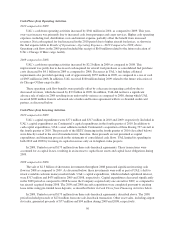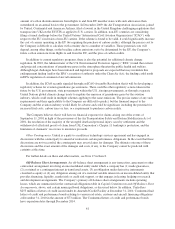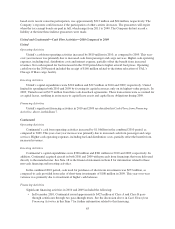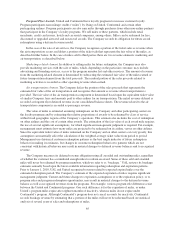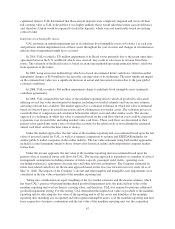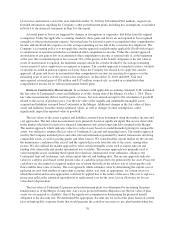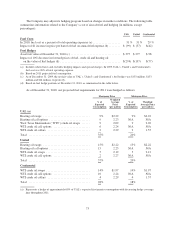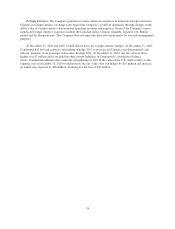United Airlines 2010 Annual Report Download - page 67
Download and view the complete annual report
Please find page 67 of the 2010 United Airlines annual report below. You can navigate through the pages in the report by either clicking on the pages listed below, or by using the keyword search tool below to find specific information within the annual report.Frequent Flyer Awards. United and Continental have loyalty programs to increase customer loyalty.
Program participants earn mileage credits (“miles”) by flying on United, Continental and certain other
participating airlines. Program participants can also earn miles through purchases from other non-airline partners
that participate in the Company’s loyalty programs. We sell miles to these partners, which include retail
merchants, credit card issuers, hotels and car rental companies, among others. Miles can be redeemed for free,
discounted or upgraded air travel and non-travel awards. The Company records its obligation for future award
redemptions using a deferred revenue model.
In the case of the sale of air services, the Company recognizes a portion of the ticket sales as revenue when
the air transportation occurs and defers a portion of the ticket sale that represents the fair value of the miles, as
described further below. In the case of miles sold to third parties there are two revenue elements: marketing and
air transportation, as described below.
Marketing-related element. In addition to selling miles for future redemption, the Company may also
provide marketing services with the sale of miles, which, depending on the particular customer, may include
advertising and branding services, access to the program member list and other services. The amount of revenue
from the marketing-related element is determined by subtracting the estimated fair value of the miles earned or
future transportation element from the total proceeds. The residual portion of the sales proceeds related to
marketing activities is recorded as other operating revenue when earned.
Air transportation element. The Company defers the portion of the sales proceeds that represents the
estimated fair value of the air transportation and recognizes that amount as revenue when transportation is
provided. The fair value of the air transportation component is determined based upon the equivalent ticket value
of similar Company fares and amounts paid to other airlines for air transportation. The initial revenue deferral is
recorded as frequent flyer deferred revenue in our consolidated balance sheets. The revenue related to the air
transportation component is recorded as passenger revenue.
The value of miles is estimated assuming redemptions on the Company and other participating carriers in
the loyalty programs and by estimating the relative proportions of awards to be redeemed by class of service
within broad geographic regions of the Company’s operations. This estimate also includes the cost of redemption
on other airlines and the cost of certain other awards. The estimation of the fair value of each award mile requires
the use of several significant assumptions, for which significant management judgment is required. For example,
management must estimate how many miles are projected to be redeemed on its airline, versus on other airlines.
Since the equivalent ticket value of miles redeemed on the Company and on other carriers can vary greatly, this
assumption can materially affect the calculation of the weighted-average ticket value from period to period.
Management uses historical customer redemption patterns as the best single indicator of future redemption
behavior in making its estimates, but changes in customer redemption behavior to patterns which are not
consistent with historical behavior may result in material changes to deferred revenue balances and to recognized
revenue.
The Company measures its deferred revenue obligation using all awarded and outstanding miles, regardless
of whether the customer has accumulated enough miles to redeem an award. Some of these sold and awarded
miles will never be redeemed by program members, which we refer to as “breakage.” UAL reviews its breakage
estimates annually based upon the latest available information regarding redemption and expiration patterns.
Prior to January 1, 2010, UAL and United recognized revenue related to expected expired miles over the
estimated redemption period. The Company’s estimate of the expected expiration of miles requires significant
management judgment. Current and future changes to expiration assumptions or to the expiration policy, or to
program rules and program redemption opportunities, may result in material changes to the deferred revenue
balance as well as recognized revenues from the programs. For example, various program rule differences exist
between the United and Continental programs. One such difference is for the expiration of miles, as under
United’s program miles expire after eighteen months of inactivity, whereas miles do not expire under
Continental’s program. Although Continental’s program does not cancel accounts for inactivity, Continental
records breakage revenue by estimating that a portion of the miles will never be redeemed based on statistical
analysis of several years of sales and redemptions of miles.
65



